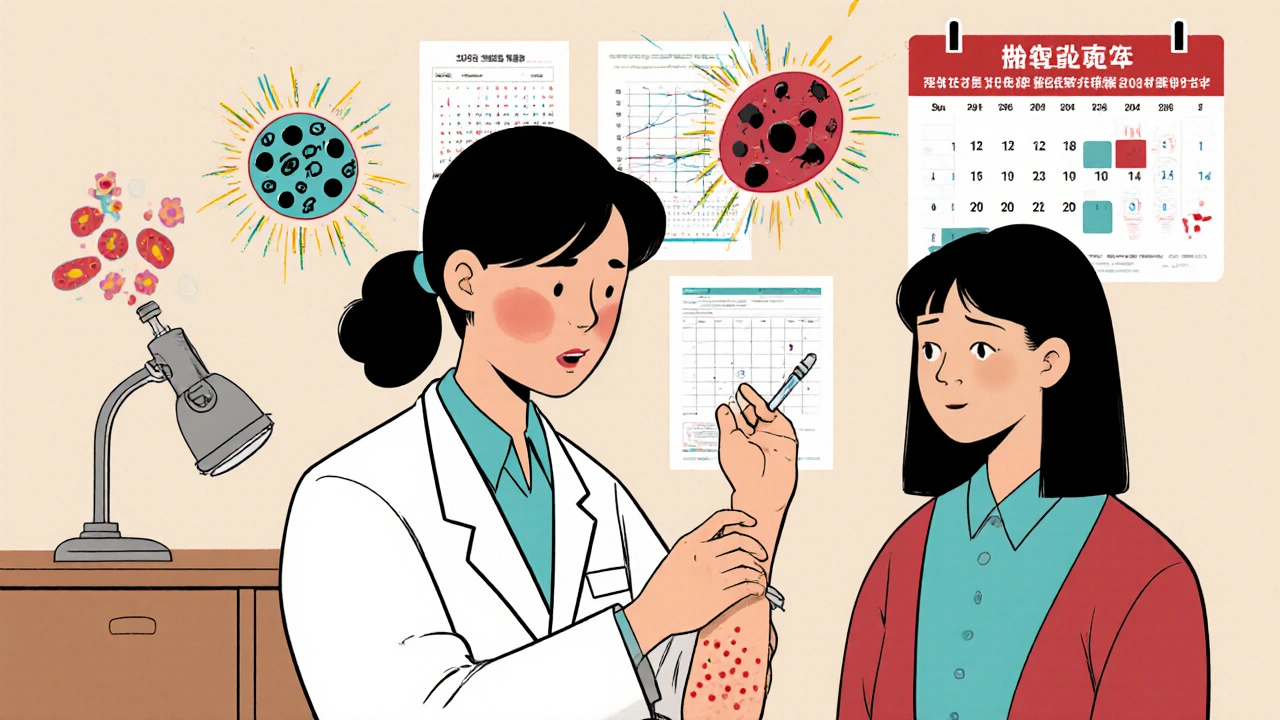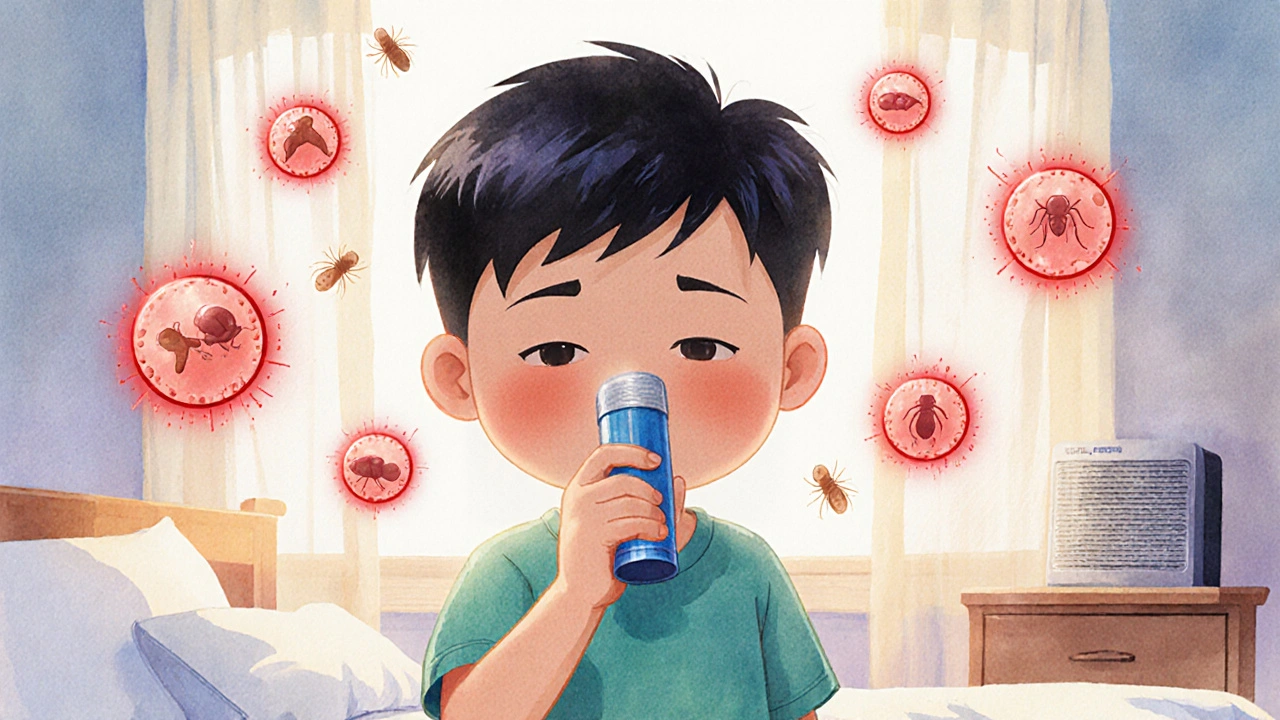If you have asthma and find your symptoms flare up every spring, after petting a cat, or during humid weather, you’re not alone. About 60% of adults with asthma have it because of allergies. This isn’t just coincidence-it’s a direct link between your immune system’s overreaction to harmless substances and the swelling in your airways. Managing this overlap isn’t about treating asthma or allergies separately. It’s about stopping the cycle where one fuels the other.
Why Allergies Make Asthma Worse
When you breathe in something like pollen, dust mites, or pet dander, your body may mistake it for a threat. If you’re allergic, your immune system releases IgE antibodies, which then trigger mast cells to dump histamine and other chemicals into your lungs. That’s when your airways swell, tighten, and produce extra mucus. The result? Wheezing, coughing, chest tightness, and shortness of breath-all classic asthma symptoms. This isn’t just about feeling uncomfortable. Allergic asthma leads to more emergency room visits, especially during peak pollen season. CDC data shows emergency visits for asthma can spike by 30-50% when ragweed or tree pollen levels are high. Kids are especially vulnerable: 80% of children with asthma have allergies, compared to about 50% of adults. The pattern often follows what’s called the “allergic march”-eczema first, then allergic rhinitis, then asthma.How Doctors Diagnose the Overlap
Diagnosing allergic asthma isn’t just about listening to your lungs. It’s about connecting the dots between your symptoms and what you’re exposed to. If your asthma gets worse around pets, after cleaning, or during certain seasons, that’s a red flag. The gold standard for testing is skin prick testing. A tiny drop of allergen is placed on your skin, then lightly pricked. If you’re allergic, a small red bump appears within 15 minutes. This test is 95% accurate for common triggers like dust mites, cat dander, and grass pollen. Blood tests that measure specific IgE levels are also used, especially if skin testing isn’t possible. Doctors also look at lung function. Spirometry checks how much air you can blow out and how fast. If your numbers improve after using a rescue inhaler, that’s reversible airflow obstruction-a key sign of asthma. When this matches up with positive allergy tests and symptom patterns, the diagnosis is clear.What Works: Managing the Triggers
Avoiding allergens sounds simple, but it’s often harder than it looks. Dust mites live in bedding, carpets, and stuffed animals. Pet dander sticks to clothes, furniture, and HVAC systems. Mold thrives in damp bathrooms and basements. Effective avoidance isn’t about perfection-it’s about reduction. Use allergen-proof mattress and pillow covers. Wash bedding weekly in hot water (at least 130°F). Keep pets out of the bedroom. Use a HEPA filter vacuum at least once a week. Fix leaks and use dehumidifiers to keep indoor humidity below 50%. These steps don’t eliminate allergens overnight, but they can cut exposure by 60-85% over time. Apps like Allergy Alert give hyperlocal pollen forecasts based on your zip code, helping you plan outdoor activities. One patient in Dunedin switched her morning runs from October to March after realizing her asthma flared every time the wind carried ragweed from nearby fields. Small changes like that make a real difference.Medications That Target the Root Cause
Inhaled corticosteroids are the first-line treatment for most asthma patients, but they work even better when allergies are involved. People with allergic asthma respond to these medications 60-70% of the time, compared to just 40-50% for non-allergic asthma. That’s because steroids directly calm the eosinophil-driven inflammation that allergies trigger. Leukotriene modifiers like montelukast help too. They block chemicals released during allergic reactions that cause airway narrowing. They’re often used alongside inhalers, especially for kids or people who can’t use steroids. But if your asthma still isn’t under control, it’s time to think beyond daily inhalers.
Allergen Immunotherapy: The Only Treatment That Changes the Course
Allergen immunotherapy-commonly called allergy shots or sublingual tablets-is the only treatment that actually changes how your immune system responds to allergens. It works by slowly exposing you to tiny, increasing amounts of the substance you’re allergic to. Over time, your body learns not to overreact. Studies show it reduces asthma symptoms by 40-60% and cuts medication use by nearly half. One patient cut her rescue inhaler use from four times a week to once a month after removing her cat and starting dust mite shots. After two years, she was off oral steroids entirely. The catch? It takes time. The build-up phase lasts 3-6 months, with weekly shots. Then you switch to monthly maintenance for 3-5 years. About 65% of people quit before reaching the 2-year mark because it feels slow or inconvenient. But those who stick with it often see long-term benefits: fewer flare-ups, less reliance on meds, and even prevention of new allergies. Sublingual tablets-placed under the tongue daily-are a good alternative for people who hate needles. They’re approved for grass, ragweed, and dust mite allergies. Coverage varies, and out-of-pocket costs can hit $250-$400 per year, depending on your plan.Biologics: Precision Medicine for Severe Cases
If you’re on high-dose inhalers and still having flare-ups, you might be a candidate for biologic therapy. These are injectable or infused drugs that target specific parts of the immune system. Omalizumab (Xolair) blocks IgE, the antibody that starts the allergic chain reaction. Clinical trials showed it cuts asthma exacerbations by 50% in allergic asthma patients. Dupilumab (Dupixent) blocks IL-4 and IL-13, two key inflammation drivers. Tezepelumab (Tezspire), approved in 2021, works even for non-allergic asthma, reducing flare-ups by 56% regardless of allergy status. The downside? Cost. These drugs run $25,000-$35,000 per year. But for people with frequent hospital visits or steroid dependence, they can save money in the long run. One study found biologics reduced asthma-related hospitalizations by 40% in severe cases.What Doesn’t Work (And Why)
Some people try herbal remedies, air purifiers without HEPA filters, or “detox” diets. These don’t touch the core problem: your immune system’s misfire. Also, don’t assume your asthma is “just” allergies. Some patients have both allergic and non-allergic triggers-like cold air, exercise, or stress. Treating only the allergy side can leave other triggers unaddressed. That’s why doctors now use biomarkers like blood eosinophils and FeNO (fractional exhaled nitric oxide) to see what type of inflammation you have. As one pulmonologist put it: “Allergy is a major player, but not the only one. You need to know what’s driving the fire before you try to put it out.”
What Patients Really Say
On asthma forums, the stories are mixed. One person wrote: “I didn’t realize my cat was the problem until I got tested. I gave him to my sister. My breathing improved within weeks.” Another said: “I did allergy shots for three years. I hated the shots, but I haven’t needed an emergency inhaler in two years.” But many report frustration. Insurance often doesn’t cover allergy testing or immunotherapy fully. One Reddit user said: “I paid $380 out of pocket just for the skin test. Then they said I needed a follow-up in six weeks. I couldn’t afford it.” The biggest complaint? The wait. “It takes months to feel better,” said a 14-year-old on a support group. “I wanted it to work yesterday.”Where the Field Is Headed
New research is making treatment smarter. Multi-allergen tablets-targeting five common allergens at once-are in phase 3 trials and show 68% symptom reduction. That could replace multiple single-allergen shots. Combining immunotherapy with biologics like dupilumab is showing even bigger gains. One trial found patients improved 75% more with both than with either alone. The goal? Move from treating symptoms to changing the disease. The Global Asthma Network estimates that properly managing the allergy component could reduce global asthma deaths by 25% by 2030. But access remains a problem. In low-income areas, 75% of asthma patients can’t get basic allergy testing. That’s a gap we can’t ignore.What You Can Do Today
If you have asthma and suspect allergies are making it worse:- Track your symptoms. When do they get worse? What were you doing or where were you?
- Ask your doctor for allergy testing. Don’t wait until you’re in crisis.
- Start with simple environmental changes: wash bedding weekly, use HEPA filters, keep pets out of the bedroom.
- If you’re still struggling, ask about biologics or immunotherapy. These aren’t last resorts-they’re tools to regain control.

Oh wow, another one of those ‘allergies cause asthma’ fairy tales. You know what really causes asthma? Pollution, GMOs in your food, and 5G towers messing with your lung cells. They don’t want you to know this because Big Pharma makes billions off inhalers. I’ve been breathing raw apple cider vinegar vapor since 2018 and haven’t touched a puff in 6 years. Try it. Or keep buying your $300 biologics. Your choice.